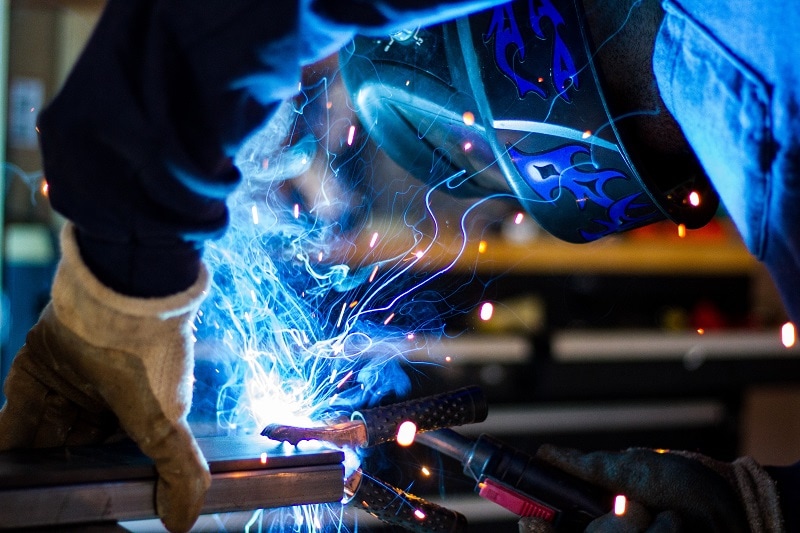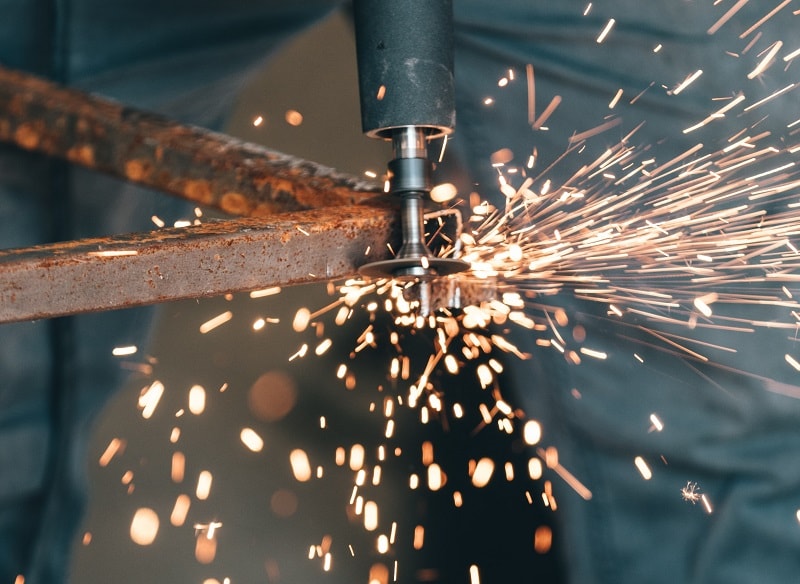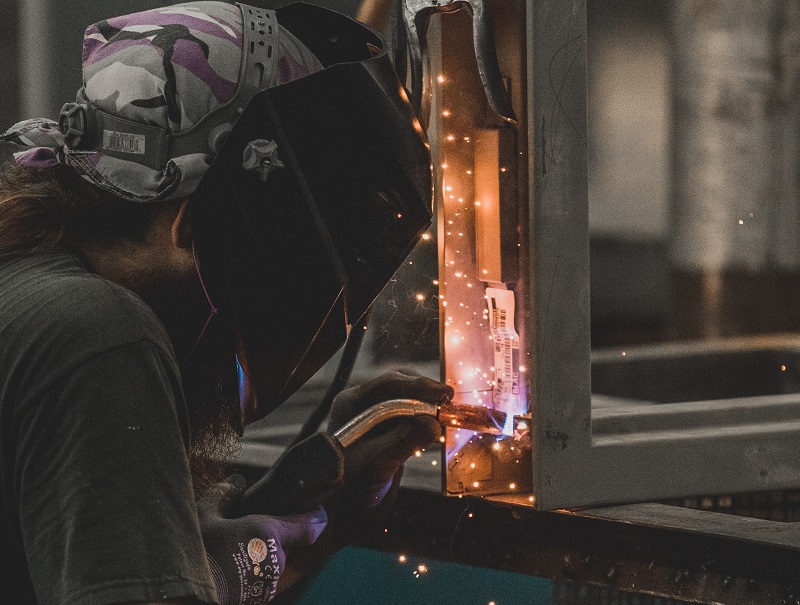What is Forge Welding? Understanding it Thoroughly
Last Updated on

With frequent practice, they can finally perfect the craft. In this article, we shall discuss everything you need to know about forge welding. Read on to learn more!
What is Forge Welding?
It’s a solid-state welding procedure that attaches two metal parts through heating them to extreme temperatures and then striking them together. This procedure is one of the easiest ways of connecting metal and has been in use since time immemorial.
It’s an all-around process because it can connect similar and different metals. In most commercial settings, forge welding has been replaced due to the discovery of electrical and gas.
Solid-state diffusion enables forge welding between similar metals. It leads to a weld seam that comprises the welded metals only, and has no bridging or filler materials. The creation of a lower melting temperature between the materials causes forge welding between distinct metals.
For this reason, the weld seam is usually strong as compared to the individual metals. Usually, 50 to 90 percent of the thawing temperature is needed to forge weld. Iron welds at a higher temperature than steel. The metal may appear shiny or damp at the welding temperature. You have to be cautious to stop overheating the metal to the extent that it emits sparks from fast oxidation.

How Does it Work?
Getting the Materials Ready
Welding heat differs depending on the metal type you’re using. Ensure that you double-check the forging temperature before heating your metals. Make sure they turn yellow when exposed to high heat in your forge.
The carbon in the metal begins to oxidize and destroys your metal if you heat beyond this point. Over time, the temperature and the color of the forge weld will become more acquainted.
Fluxing
Move your materials away from the forge and sprinkle them using flux. The forged section of the crucible utilizes borax as a flux. Flux acts as glassy protection that stops the corrosion of steel. Flux is a reducing agent that prevents oxidation.
Oxidation leads to scales or slag on the surface that can stop your metal from welding. Any contaminated or soiled metal will form a feeble joint and increase the metal’s melting temperature. When forge welding, flux is necessary, particularly as a beginning if you’re in a blacksmith’s shop.
Heating
After you’ve completed applying flux, put the metal back in the forge. Heat it until it turns radiant yellow. Don’t let it stay in the forge for long because your metal may spark, which implies that your metal is contaminated.
Don’t forget that every metal has a different welding temperature. Therefore, before you begin the procedure, it’s a good idea to examine your metals.
Connecting and Hammering
When your metal piece glows radiant yellow, take it out of the forge. You must perform forge welding to stop your material from becoming too soft. You can use metal wires to attach your parts until the main weld is created.
To join the weld seam, take your piece to the hydraulic press or power hammer. Make sure that you don’t hammer the metal too hard to slip the weld seam out of position. Repeat it until you have a clean-finished weld that doesn’t have weld lines.
Keeping Yourself Safe When Forge Welding

Protect your Eyes
Safety glasses are a requirement. Some blacksmiths may even wear a welding helmet.
Put On a Mask
Safeguard your lungs by putting on respiratory protection when handling sultry metals that may emit gases.
Wear Safety Gloves
Put on gloves when near your forge mouth. Don’t put on gloves if you’re near machinery that may grip fabric – lathe, a drill press, or more.
Put on the Right Apparel
Never put on artificial apparel in the forge. Also, keep away from 100% thin cotton fabric. Any kind of sparks will lead to the melting of synthetics and, therefore, making them stick to your skin. Thin all-natural fabrics can also alight in extreme circumstances.
Put on thick 100% all-innate materials such as wool or leather. A leather apron is an excellent investment! Also, ensure that you’re not putting on any baggy clothing or pieces that a machine can grasp.
Safeguard your Ears
Even if you don’t utilize noisy tools frequently, muffs or earplugs are a great wont to get into.
What are the Different Types of Forge Welding?
The oldest welding technique is forge welding and has been in use since time immemorial. Usually, welding procedures can be categorized into two types: Diffusion and fusion welding:
1. Fusion Welding
The first approach (fusion welding) is possibly what you’re acquainted with. In this process, two separate metal pieces are connected by applying a certain amount of heat so that you can mold the metal parts together. At this juncture, all we’ve stated revolves around fusion welding.
There’s no pressure needed during this procedure. Fusion is used in gas welding, arc welding, and resistance welding. If you’re fusing distinct metal types, fusion welding is the best bet.
2. Diffusion Welding
On the contrary, there are situations when the heat isn’t needed. The temperature of the metals involved in diffusion welding regularly stays below the critical temperature. It’s called solid-state or diffusion welding.
The key to this procedure is pressure, not heat. Roll and friction welding is the most common type of diffusion welding.
What Materials Can You Forge Weld?
So, what metal types are we talking about? When it comes to forging welding, you can use a wide variety of materials. From aluminum, iron, brass, copper, and, of course, steel, there are various choices.
Nonetheless, in numerous instances, steel is the most commonly used metal. The steel can be in the shape of a flat sheet, bar, or any other type. Indeed, the steel can be low or high carbon provided it can be heated to a sufficiently high temperature to be flexible or moldable.
What Tools Are Necessary for Forge Welding?
- A source of heat – You can use sultry coals.
- Any metal you prefer – You can also use similar or distinct metal types.
- Hardy device – Use any tool that’ll help in bending your metal as soon as it has reached the required temperature.
- Hydraulic press or power hammer – For flattening and molding your sultry metal.
- Flux – Assists in getting rid of corrosion and forming a sticky surface.
Where is it Used?
In the past, forge welding has been used to fabricate numerous items out of iron and steel. It has been used to make most items, from making farming tools, cookware, and the fabrication of gates, fences, and constructing prison cells.
During the early Industrial Revolution, until the advent of fusion-welding, forge welding was mostly used to fabricate boilers and pressure vessels. It was widely used to manufacture armor and weapons in the Middle Ages.
Among the most popular uses of this welding procedure is the manufacture of blades that are pattern-welded. In this procedure, a blacksmith frequently draws out a piece of steel, bends it back, and welds it on itself.
The other use of forge welding was in making shotgun casks. A metal wire was wound onto a spindle, and finally, formed into a thin, even, and strong barrel. In several instances, items that are forge-welded are acid-etched to uncover the underlying metal pattern. It’s unmatched to every item, and is esthetically pleasing.
Tips on Forge Welding
Forge welding can be complicated
Though forge welding appears like a cut and dry procedure, there are few key factors that you have to take into account:
- Good hand-eye synchronization is crucial if you’re working in surroundings where you’ll be exposed to excessive heat.
- Care and patience are essential to keep accidents at bay.
- For effective timing of every welding step, speed and correctness are necessary.
Temperature is Key
As we mentioned earlier, the temperature requirements differ depending on the materials you’re forge welding.
Therefore, you need to comprehend the distinct materials and follow the right standards for the material you chose. You cannot ignore the fact that the metal has to be sufficiently heated to fuse.
Flux Creates a Discrepancy
Selecting the best welding flux for your type of project and materials makes all the difference. Knowing which material is best for coating a particular metal and which is acidic enough to corrode the metal eases your effort.
Security
Last but not least, following the right security measures is crucial. Hot items are risky; chemicals can be toxic, and acuminated things cut. There could be a recipe for disaster if you put all these risky elements in one room.
Nevertheless, being cognizant is the first step, and keeping your room arranged and free of clutter will also make a difference.
Commonly Forge Welded Items
- Airplanes
- Farming gear
- Bikes
- Crankshaft
Advantages of Forge Welding
- Since the purpose of any welding procedure is to get premium quality weld at the joint, you’ll attain this goal with this welding procedure. You can get a clear joint fast and easy.
- Little noise is generated during this process. It’s because of this that forge welding is considered to be the best welding procedure.
- Dissimilar to other welding procedures, this welding approach needs no filler metal.
- If you want to produce high-strength welds, then forge welding is the ideal welding procedure for you. The weld seams with the higher strength are created with the clean and crystal-clear weld seam.
- If you’re doing forge welding, you should have the expertise required to do so. It’s hard to use it and, therefore, the right skills are needed to perform this procedure.
- This welding procedure is one of the slowest welding processes. It’s because carrying out this welding process using hands is somewhat time-consuming.
- Sometimes there’s a possibility that the weld may become contaminated with the coke. Therefore, you should be more careful so that contamination doesn’t take place.
FAQs
Is forge welding powerful?
Yes, it is. Forging includes heating and shaping the metal again. Usually, the diffusion connection of a forge weld is more powerful as compared to a fusion weld, where the metal is changed into a liquid.
The high heat in combination with pressure increases the material’s strength considerably. During forging, steel conforms to the new shape, and the distorted particle structure increases strength considerably.
Should you use flux when it comes to forge welding?
Yes, you can utilize flux in forge welding. Borax gets rid of any corrosion. Corrosion forms a layer above the steel, creating a defective weld between the two metal pieces. It combines with the oxidation, becomes viscous, and pushes itself out of the joint.
You may perceive this leaking out of your pieces. It’s called slag, and it assists in sealing the weld.

Can you attach two distinct metal types when forge welding?
Using the correct approach, pressure, and heat, you can forge weld any two metal pieces into one.
What’s the ideal temperature for forge welding?
Forging temperatures differ depending on the metals you’re forging. Distinct metals need different temperatures. Also, the amount of heat required by each piece is different.
Some ferric metals such as aluminum need low temperatures to heat and are also easy to shape. Many aluminum alloys can get to a temperature of 800 degrees Fahrenheit. On the contrary, steel requires a temperature of about 2,000 Ddegrees Fahrenheit.
Final Thoughts
Whether you want to become an expert blacksmith or just want to start forge welding in your garage for enjoyment, this article has provided you with everything you should know to start. Through continued practice and the knowledge base we have offered, you can be skillful when it comes to forge welding. We hope you have learned what forge welding is and wish you the best on your project!
Featured Image Credit: Rob Lambert, unsplash
